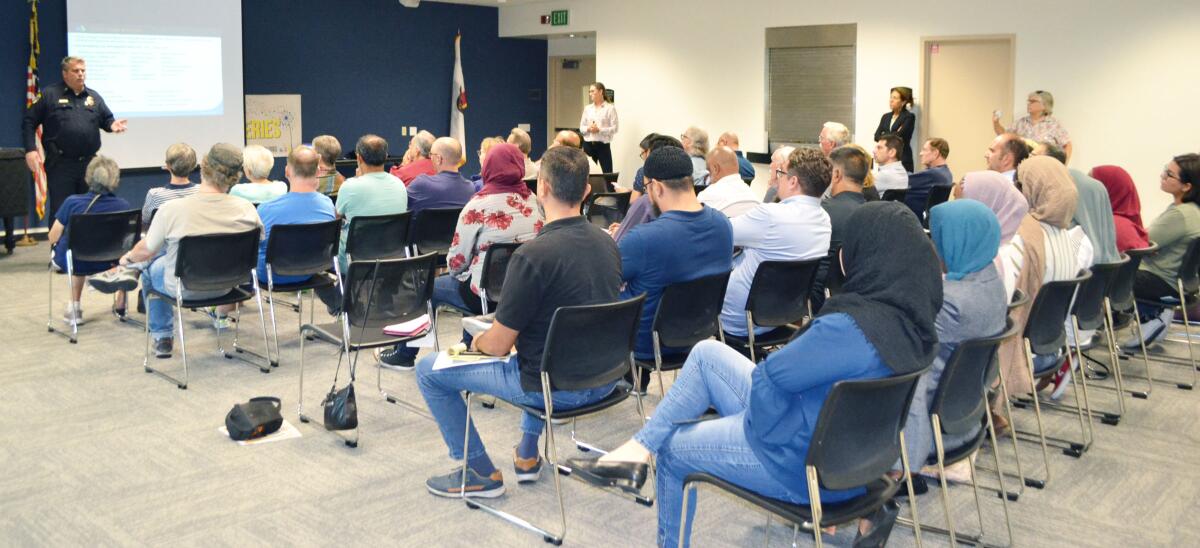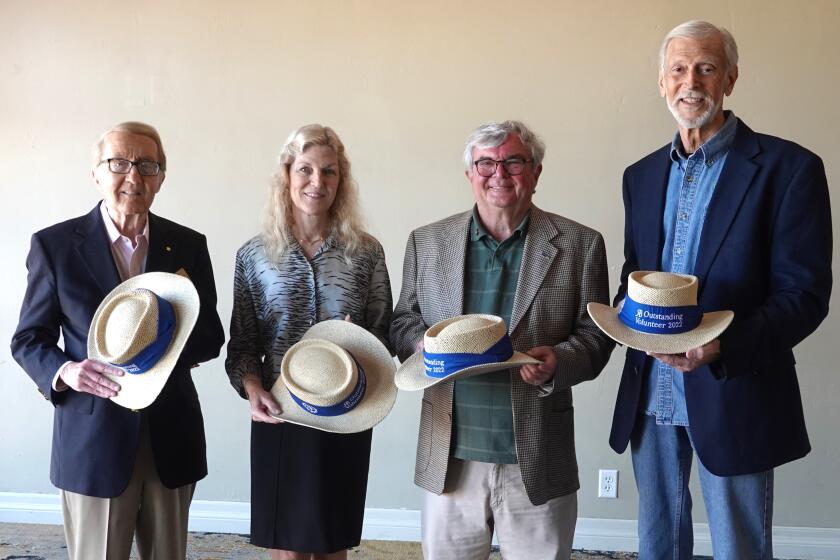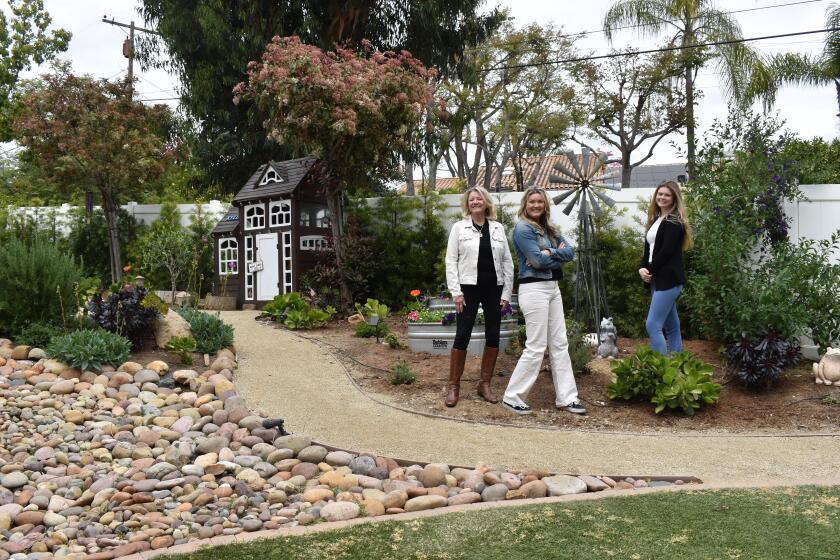Concerns raised over City of San Diego’s Smart Streetlights program

With many mentioning privacy, program oversight and transparency, potential misuse, businesses profiting and being watched by “Big Brother,” a planned hour-long meeting on the new Smart Streetlights installed citywide turned into a two-hour session with more than a dozen of the 40-plus attendees voicing concerns.
The final session of 11 City of San Diego officials have held since mid-June to explain to the public about its Smart Streetlight program was held Tuesday night at the Rancho Bernardo Library. Following a brief overview, there was an apology from Lindsey Hawes, the city’s municipal energy program manager, for meeting not being held a year earlier before the first phase of installations began.
“With any new technology there are lessons learned,” Hawes said. “We are constantly learning about operational and procedural issues and generating metadata we can make available to the public. We learned a lesson on public engagement. It probably would have been better if you were contacted a year ago, to voice concerns before phase one.”
Hawes, who has been in the position for three months, said the written and oral comments generated through the meetings will be used by city officials as they develop new policies, revise existing policies and take to the City Council over the coming months more information before the second phase of installations commences. It is slated to be complete by next spring.
Hawes said the city’s Smart Streetlights project began as a cost-savings effort for the city to replace high energy use streetlights with more efficient LED lights. However, officials learned additional options to collect metadata — counts of pedestrians, bicyclists, vehicles and empty parking spaces, for example — were available through CityIQ sensor nodes and decided to install the data-gathering cameras in addition to the light sensors to help in future city projects and app developments.
“It is a great opportunity ... to collect data and understand how people are moving around the city,” Hawes said.
She showed a video of how the camera can measure the pace of pedestrians and said that could potentially be used to adjust a street signals’ timing to allow more time for a slower-moving pedestrian — like a senior — to cross at an intersection.
As for the streetlights’ energy saving capabilities, she said instead of just turning on lights full strength, based on the available natural light, the intensity could be adjusted gradually at dusk and dawn so the light output can be dimmed when needed.
According to a fact sheet, “With 4,700 LED streetlights already installed the city is beginning to see monthly energy savings around $70,000. After the full deployment of 8,000 LED streetlights we expect savings of about $125,000 per month. This doesn’t include additional expected savings associated with reduced maintenance, daily dimming and switching to special streetlight energy rates with SDG&E.”
While the attendees did not voice objections over the adjustable LED features of the lights, many were very concerned over the CityIQ sensor nodes attached to some lights since the cameras record data saved for five days and can be used by law enforcement during investigations.
Even though the city began the project in 2016, police Capt. Jeff Jordan said San Diego Police Department only learned of the technology’s capabilities last year and since then he has been working with the City Council and others, such as the ACLU, to develop policies on what can and cannot be done with the data within legal parameters.
The system cannot view private property. If at installation any is within camera range, the area is obscured and nothing within the obstruction recorded. The camera also cannot pan, tilt or zoom.
Jordan said it only captures images within the public right-of-way, where there is no expectation of privacy. It also does not have facial recognition capabilities, no license plate reader feature and other than ambient noise, has no audio capabilities. There is the potential to have a feature that can triangulate gun shot sounds to determine location.
Jordan said the technology has been rarely used by police. Of 500,000 calls to which police respond, since last August it has been utilized in 164 investigations and fewer than 100 of the city’s 1,800 police officers have access. They are mostly in the homicide, robbery, sex crimes and traffic units. Their access is also audited and the footage is available to the media and others through California Public Records Act requests.
“It is not used to harass, intimidate or discriminate against any individuals or groups,” Jordan said.
The first case in which it was used was in August 2018 during a homicide investigation for a fatal shooting in the Gaslamp area at 1:30 a.m. Video footage showed two individuals involved in a “pretty violent fight,” during which the deceased attacked the shooter with a barricade prior to the arrested person shooting him.
“It was a different situation than originally thought and ultimately (the district attorney) dropped the charge of murder,” Jordan said.
Footage is not watched in real time and only after an incident do police request camera footage, if available. Jordan said videos have assisted in investigations of fatal vehicle and pedestrian accidents and while trying to identify those involved in crime series, such as an ongoing case of someone shooting at businesses with a BB gun.
In October 2018, a store owner was executed during a robbery and the assailant wore a clown mask. A few blocks away a camera on a streetlight caught the individual removing his mask and he happened to look up. With a good image of his face, police were able to see who it was.
“This is a crime we don’t solve if we don’t have that footage,” Jordan said.
But the fact that the image was sharp enough to allow for identification was among objections many meeting attendees raised. Some asked about federal agencies being given access to the footage, especially since audience members said they questioned the nodes’ placement and who in the city determined the locations, something Hawes said she did not know. Jordan said the police department was not asked for location input and only found out about the program following installation.
Jordan said SDPD — through the region’s Joint Terrorism Task Force — would be willing to share data with other investigators during violent crimes, such as the recent Poway synagogue shooting. (The suspect was captured within the City of San Diego.)
“Solving crimes while balancing with people’s privacy rights is a big deal,” Jordan said, adding policies on procedures for video usage “are not written in stone” and as the technology develops future changes are likely.
“I get that you are angry about (this) and the police department is not exactly happy ... about the randomness (of placement),” Jordan said.
One audience member said the CityIQ sensor nodes were placed around 14 of 15 mosques in the city. Another said based on the map there was a higher concentration of sensors in communities of color, especially south San Diego where some attendees said they live.
The city is one of the earliest adopters of the technology throughout the United States. Several attendees said they would like to know what privacy policies other cities have implemented and see San Diego incorporate those assurances since they see the cameras as invasive of their privacy and First Amendment rights, including freedom to gather and practice religion.
An interactive online map to see where every CityIQ sensor node within the city is located or will be installed is at cityiqmapsd.herokuapp.com.
For website links on city policy restricting use of sensor data, the police department’s policy governing use of video for serious crime investigation and the city’s open data policy, go to the frequency asked questions page at tinyurl.com/SDSmartStreetlights.
Get the Pomerado News in your inbox weekly
Top headlines from Poway, Rancho Bernardo and 4S Ranch, every Thursday for free.
You may occasionally receive promotional content from the Pomerado News.





